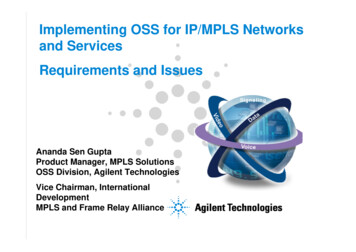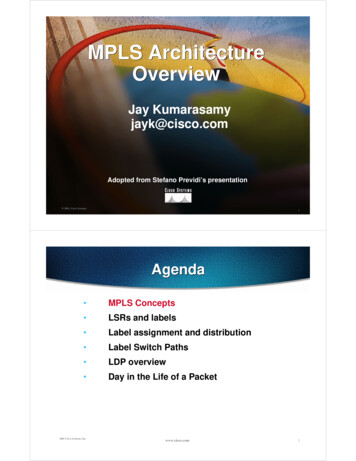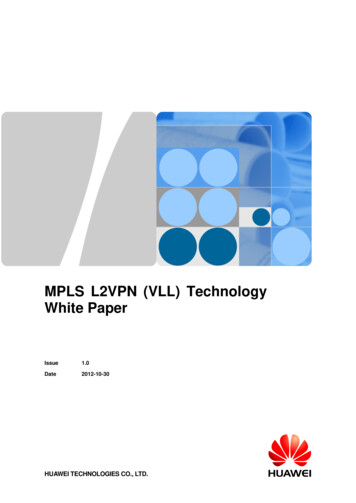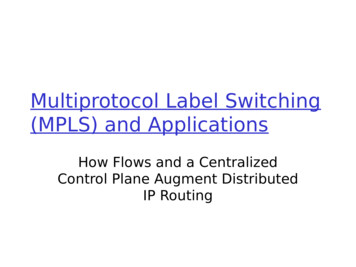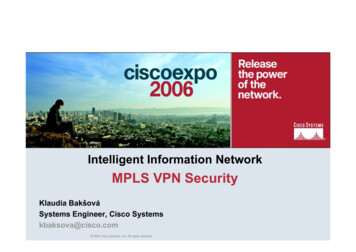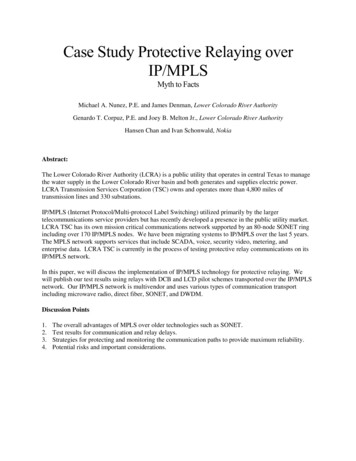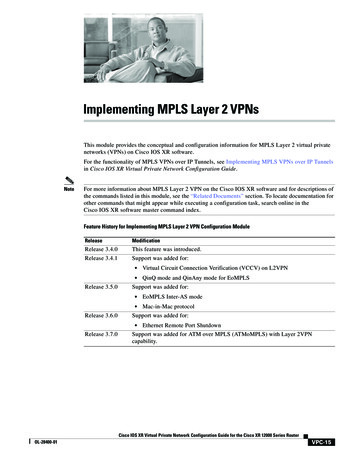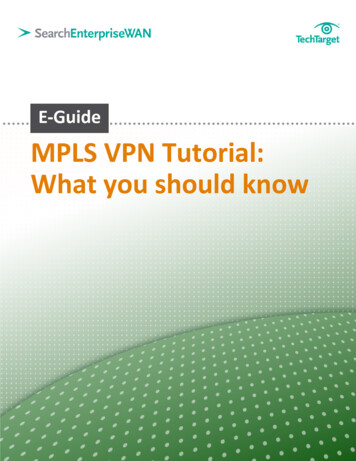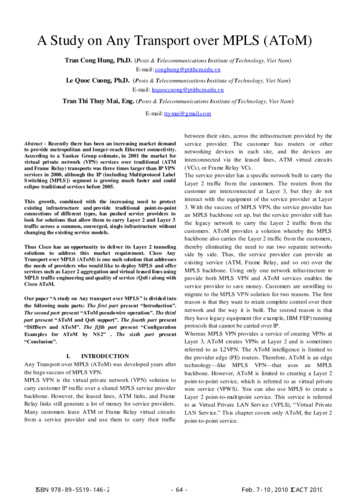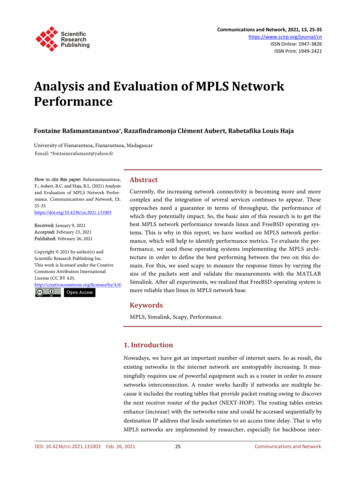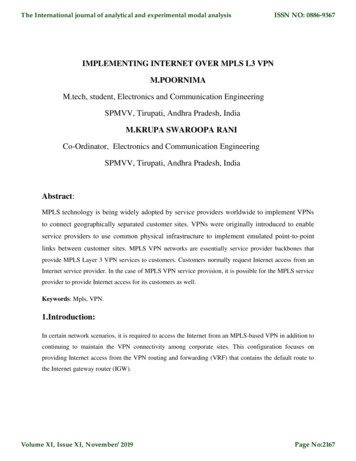
Transcription
The International journal of analytical and experimental modal analysisISSN NO: 0886-9367IMPLEMENTING INTERNET OVER MPLS L3 VPNM.POORNIMAM.tech, student, Electronics and Communication EngineeringSPMVV, Tirupati, Andhra Pradesh, IndiaM.KRUPA SWAROOPA RANICo-Ordinator, Electronics and Communication EngineeringSPMVV, Tirupati, Andhra Pradesh, IndiaAbstract:MPLS technology is being widely adopted by service providers worldwide to implement VPNsto connect geographically separated customer sites. VPNs were originally introduced to enableservice providers to use common physical infrastructure to implement emulated point-to-pointlinks between customer sites. MPLS VPN networks are essentially service provider backbones thatprovide MPLS Layer 3 VPN services to customers. Customers normally request Internet access from anInternet service provider. In the case of MPLS VPN service provision, it is possible for the MPLS serviceprovider to provide Internet access for its customers as well.Keywords: Mpls, VPN.1.Introduction:In certain network scenarios, it is required to access the Internet from an MPLS-based VPN in addition tocontinuing to maintain the VPN connectivity among corporate sites. This configuration focuses onproviding Internet access from the VPN routing and forwarding (VRF) that contains the default route tothe Internet gateway router (IGW).Volume XI, Issue XI, November/2019Page No:2167
The International journal of analytical and experimental modal analysisISSN NO: 0886-93671.1.Static routing:Refers to routes to destinations being setup manually in the router. Network reachability in this case is notdependent on the existence and state of the network itself. Whether a destination is up or down, the staticroutes would remain in the routing table, and traffic would still be sent towards that destination. Staticrouting generally is not sufficient for large or complex networks because of the time required to defineand maintain static route table entries.1.2. Dynamic Routing:Refers to a ―last resort outlet‖ – traffic to destinations that are unknown to the local router are sent to thedefault outlet router. Default routing is the easiest form of routing for a domain connected to a single exitpoint. A default route is a path on which a router should forward a packet if it does not have specificknowledge about the packet‗s destination.2.OSPF Protocol:Enterprise networks that outgrow a single site will often use OSPF to interconnect their campuses andwide area networks (WANs).If you‘re considering a dynamic routing protocol because your network hasoutgrown static routes, OSPF might seem a little daunting. It‘s not quite as easy to set up as EIGRP so thetemptation might be to simply use EIGRP and avoid the intimidating terminology that comes along with acomplete understanding of OSPF. Consider a simple example of five routers connected as shown in thediagram below. Assuming all links have the same cost, what‘s the fastest way for R3 to connect to R5Through R4 — R4 is the lowest cost path. (R3‘s path to R5 via R1, for example, adds another link andtherefore additional cost.)Volume XI, Issue XI, November/2019Page No:2168
The International journal of analytical and experimental modal analysisISSN NO: 0886-93672. Internal BGP:Internal BGP (IBGP) is the form of BGP that exchanges BGP updates within an AS. Instead of IBGP, theroutes learned via EBGP could be redistributed into IBGP within the AS and then redistributed again intoanother AS. However, IBGP is more flexible, provides more efficient ways of controlling the exchange ofinformation within the AS, and presents a consistent view of the AS to external neighbors.Fig: Ibgp Example3. MPLS VPN Schematic overview model:All the service providers provide the common infrastructures that are used by customers.Figure. MPLS VPN schematic overviewVolume XI, Issue XI, November/2019Page No:2169
The International journal of analytical and experimental modal analysisISSN NO: 0886-9367There are two types of routers in the service providers‘ network, i.e., Provider Edge (PE) and Provide (P)routers. The Provider Edge router is directly connected to the Customer Edge (CE) router of the customernetworks. The customer edge (CE) router is directly connected to the PE router at layer 3 while thecustomer (C) router is not directly connected to the PE router. The CE router does not need to run MPLSbecause the PE and CE routers interact at layer 3 using a routing protocol or static routing. The CE routercan only peer with one PE router and cannot have peering with another CE router on another site acrossthe provider network. The peer-to-peer model is the outcome of peering between PE and CE routers atlayer 3.4. MPLS VPN architecture:There are three fundamental building blocks on PE routers. They are as following:Virtual Routing Forwarding (VRF):Virtual Routing Forwarding (VRF) is a technology used in VPN routing and forwarding instance. It isthe combination of VPN routing table, the associated IP routing protocols, and the VRF Cisco ExpressForwarding table. It allows these multiple instances of the routing table to exist in the same router andperform simultaneously. In a PE router, there must be separate and private routing for each VPN which iscalled VRF routing table.Route Distinguisher (RD):Multiprotocol BGP (MP-BGP) is used by the VPN to propagate its prefixes over the MPLS VPNnetworks. The IPv4 prefixes carried by BGP across the service providers‘ network should be unique. Ifthere is overlapping in the customers‘ IP addressing, there will be a problem in routing. To overcome thisproblem, the route distinguisher concept was developed to make IPv4 prefixes unique. The idea is that aunique identifier is received from each customer with each prefix to differentiate the same prefix fromother customers.Volume XI, Issue XI, November/2019Page No:2170
The International journal of analytical and experimental modal analysisISSN NO: 0886-9367Route Targets (RTs)A Route Target is the feature of MPLS VPN which controls the communication between different VPNsites. The Route Target (RT) was introduced to overcome the drawbacks of the route distinguisher (RD)since the RD can only communicate with one VPN; whereas RT can communicate with complex VPNtopologies.5.Results:Fig: ospf routingFig: internet routing from customer to customer networksfffFig:Ospf databaseVolume XI, Issue XI, November/2019Fig: BGP RoutingPage No:2171
The International journal of analytical and experimental modal analysisISSN NO: 0886-9367Fig: Mpls forwarding table6.Conclusion:In this study we implemented internet over mpls l3vpn. This Topology of MPLS L3 VPN alsoprovides the security between two client destinations. Layer 3 VPN routing is performed betweencustomer edge device and Provider Edge device .this network vpn and internet networks combined togiven the internet access between customer and provider networks. Layer 3 has been implemented overthe Graphical Network Simulator GNS3 tool. MPLS is being utilized boundless in the Service Providersystems for the arrangement of private, business and portable administrations.7.References:1. L.Andersson et al., LDP Specification, Internet draft draft-ietf-mpls-ldp-05, June 1999.2. D. Awduche, MPLS and Traffic Engineering in IP Networks, IEEE Communications, Vol. 37,Dec. 1999.3. D. Awduche, A. Hannan, and X. Xiao, Applicability Statement for Extensions to RSVP for LSPTunnels,4. IETF Internet draft, work in progress, July 1999.5. D. Awduche et al., Extensions to RSVP for LSP Tunnels, Internet draft draft-ietf-mpls-rsvp-lsptunnel-03,6. Sept. 1999.7. D. Awduche et al., Extensions to RSVP for Traffic Engineering, IETF Internet draft, work inprogress, Feb.Volume XI, Issue XI, November/2019Page No:2172
The International journal of analytical and experimental modal analysisISSN NO: 0886-93678. 1999.9. D. Awduche et al., Requirements for Traffic Engineering Over MPLS, RFC 2702, Sept. 1999.10. L. Berger, D. H. Gan, and G. Swallow, RSVP Refresh Reduction Extensions, draft-berger-rsvprefresh-reduct,11. work in progress.12. S. Blake et al., An Architecture for Differentiated Service, RFC 2475, Dec. 1998.13. R. Braden et al., Resource ReSerVation Protocol (RSVP), Version 1 Functional specification,RFC 2205,14. Sept. 1997.15. N. Brownlee, C. Mills, and G. Ruth, Traffic Flow Measurement: Architecture, Internet RFC2063, Jan. 1997.16. R. Callon et al., A Framework for Multiprotocol Label Switching, Internet draft draft-ietf-mplsframework-Volume XI, Issue XI, November/2019Page No:2173
MPLS VPN networks are essentially service provider backbones that provide MPLS Layer 3 VPN services to customers. Customers normally request Internet access from an Internet service provider. In the case of MPLS VPN service provision, it is possible for the MPLS service provider to provide Internet access for its customers as well.
